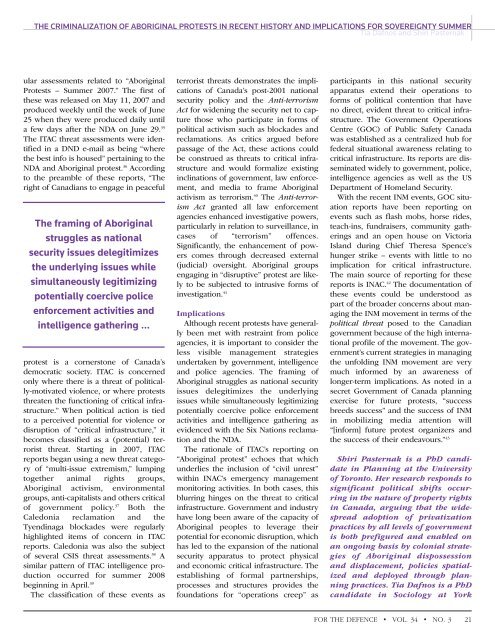FTD_Vol34_No3_web
FTD_Vol34_No3_web
FTD_Vol34_No3_web
Create successful ePaper yourself
Turn your PDF publications into a flip-book with our unique Google optimized e-Paper software.
For the Defence_34-3_Layout 1 13-08-16 10:40 AM Page 21<br />
THE CRIMINALIZATION OF ABORIGINAL PROTESTS IN RECENT HISTORY AND IMPLICATIONS FOR SOVEREIGNTY SUMMER<br />
ular assessments related to “Aboriginal<br />
Protests – Summer 2007.” The first of<br />
these was released on May 11, 2007 and<br />
produced weekly until the week of June<br />
25 when they were produced daily until<br />
a few days after the NDA on June 29. 35<br />
The ITAC threat assessments were identified<br />
in a DND e-mail as being “where<br />
the best info is housed” pertaining to the<br />
NDA and Aboriginal protest. 36 According<br />
to the preamble of these reports, “The<br />
right of Canadians to engage in peaceful<br />
The framing of Aboriginal<br />
struggles as national<br />
security issues delegitimizes<br />
the underlying issues while<br />
simultaneously legitimizing<br />
potentially coercive police<br />
enforcement activities and<br />
intelligence gathering ...<br />
protest is a cornerstone of Canada’s<br />
democratic society. ITAC is concerned<br />
only where there is a threat of politically-motivated<br />
violence, or where protests<br />
threaten the functioning of critical infrastructure.”<br />
When political action is tied<br />
to a perceived potential for violence or<br />
disruption of “critical infrastructure,” it<br />
becomes classified as a (potential) terrorist<br />
threat. Starting in 2007, ITAC<br />
reports began using a new threat category<br />
of “multi-issue extremism,” lumping<br />
together animal rights groups,<br />
Aboriginal activism, environmental<br />
groups, anti-capitalists and others critical<br />
of government policy. 37 Both the<br />
Caledonia reclamation and the<br />
Tyendinaga blockades were regularly<br />
highlighted items of concern in ITAC<br />
reports. Caledonia was also the subject<br />
of several CSIS threat assessments. 38 A<br />
similar pattern of ITAC intelligence production<br />
occurred for summer 2008<br />
beginning in April. 39<br />
The classification of these events as<br />
terrorist threats demonstrates the implications<br />
of Canada’s post-2001 national<br />
security policy and the Anti-terrorism<br />
Act for widening the security net to capture<br />
those who participate in forms of<br />
political activism such as blockades and<br />
reclamations. As critics argued before<br />
passage of the Act, these actions could<br />
be construed as threats to critical infrastructure<br />
and would formalize existing<br />
inclinations of government, law enforcement,<br />
and media to frame Aboriginal<br />
activism as terrorism. 40 The Anti-terrorism<br />
Act granted all law enforcement<br />
agencies enhanced investigative powers,<br />
particularly in relation to surveillance, in<br />
cases of “terrorism” offences.<br />
Significantly, the enhancement of powers<br />
comes through decreased external<br />
(judicial) oversight. Aboriginal groups<br />
engaging in “disruptive” protest are likely<br />
to be subjected to intrusive forms of<br />
investigation. 41<br />
Implications<br />
Although recent protests have generally<br />
been met with restraint from police<br />
agencies, it is important to consider the<br />
less visible management strategies<br />
undertaken by government, intelligence<br />
and police agencies. The framing of<br />
Aboriginal struggles as national security<br />
issues delegitimizes the underlying<br />
issues while simultaneously legitimizing<br />
potentially coercive police enforcement<br />
activities and intelligence gathering as<br />
evidenced with the Six Nations reclamation<br />
and the NDA.<br />
The rationale of ITAC’s reporting on<br />
“Aboriginal protest” echoes that which<br />
underlies the inclusion of “civil unrest”<br />
within INAC’s emergency management<br />
monitoring activities. In both cases, this<br />
blurring hinges on the threat to critical<br />
infrastructure. Government and industry<br />
have long been aware of the capacity of<br />
Aboriginal peoples to leverage their<br />
potential for economic disruption, which<br />
has led to the expansion of the national<br />
security apparatus to protect physical<br />
and economic critical infrastructure. The<br />
establishing of formal partnerships,<br />
processes and structures provides the<br />
foundations for “operations creep” as<br />
participants in this national security<br />
apparatus extend their operations to<br />
forms of political contention that have<br />
no direct, evident threat to critical infrastructure.<br />
The Government Operations<br />
Centre (GOC) of Public Safety Canada<br />
was established as a centralized hub for<br />
federal situational awareness relating to<br />
critical infrastructure. Its reports are disseminated<br />
widely to government, police,<br />
intelligence agencies as well as the US<br />
Department of Homeland Security.<br />
With the recent INM events, GOC situation<br />
reports have been reporting on<br />
events such as flash mobs, horse rides,<br />
teach-ins, fundraisers, community gatherings<br />
and an open house on Victoria<br />
Island during Chief Theresa Spence’s<br />
hunger strike – events with little to no<br />
implication for critical infrastructure.<br />
The main source of reporting for these<br />
reports is INAC. 42 The documentation of<br />
these events could be understood as<br />
part of the broader concerns about managing<br />
the INM movement in terms of the<br />
political threat posed to the Canadian<br />
government because of the high international<br />
profile of the movement. The government’s<br />
current strategies in managing<br />
the unfolding INM movement are very<br />
much informed by an awareness of<br />
longer-term implications. As noted in a<br />
secret Government of Canada planning<br />
exercise for future protests, “success<br />
breeds success” and the success of INM<br />
in mobilizing media attention will<br />
“[inform] future protest organizers and<br />
the success of their endeavours.” 43<br />
Shiri Pasternak is a PhD candidate<br />
in Planning at the University<br />
of Toronto. Her research responds to<br />
significant political shifts occurring<br />
in the nature of property rights<br />
in Canada, arguing that the widespread<br />
adoption of privatization<br />
practices by all levels of government<br />
is both prefigured and enabled on<br />
an ongoing basis by colonial strategies<br />
of Aboriginal dispossession<br />
and displacement, policies spatialized<br />
and deployed through planning<br />
practices. Tia Dafnos is a PhD<br />
candidate in Sociology at York<br />
FOR THE DEFENCE • VOL. 34 • NO. 3<br />
21



